ATHE Law for Accounting: Advising on Company Law and Compliance
VerifiedAdded on 2023/06/18
|57
|19648
|79
Project
AI Summary
This project provides legal advice on company formation, contractual agreements, intellectual property, and employment legislation, aimed at assisting Jodie Hart in establishing her training business as a limited company. It covers key aspects such as the process of company formation, financing requirements, company administration (including the roles of directors, secretaries, and other officers), shareholder responsibilities, and the advantages and disadvantages of operating as a limited company. It also addresses capital maintenance requirements and the concept of the veil of incorporation. Furthermore, the project includes an analysis of contractual agreements, data protection legislation (GDPR), intellectual property protection, and tort law, specifically focusing on negligence and vicarious liability. In addition, the project advises Dayloan Ltd on insolvency, malpractice, fraud, bribery, money laundering, computer misuse, and cybercrime, offering insights into corporate governance and ethical responsibilities. The document provides guidance on good and poor lending practices, HMRC enforcement methods, and principles of public service, integrity, and accountability in corporate conduct.
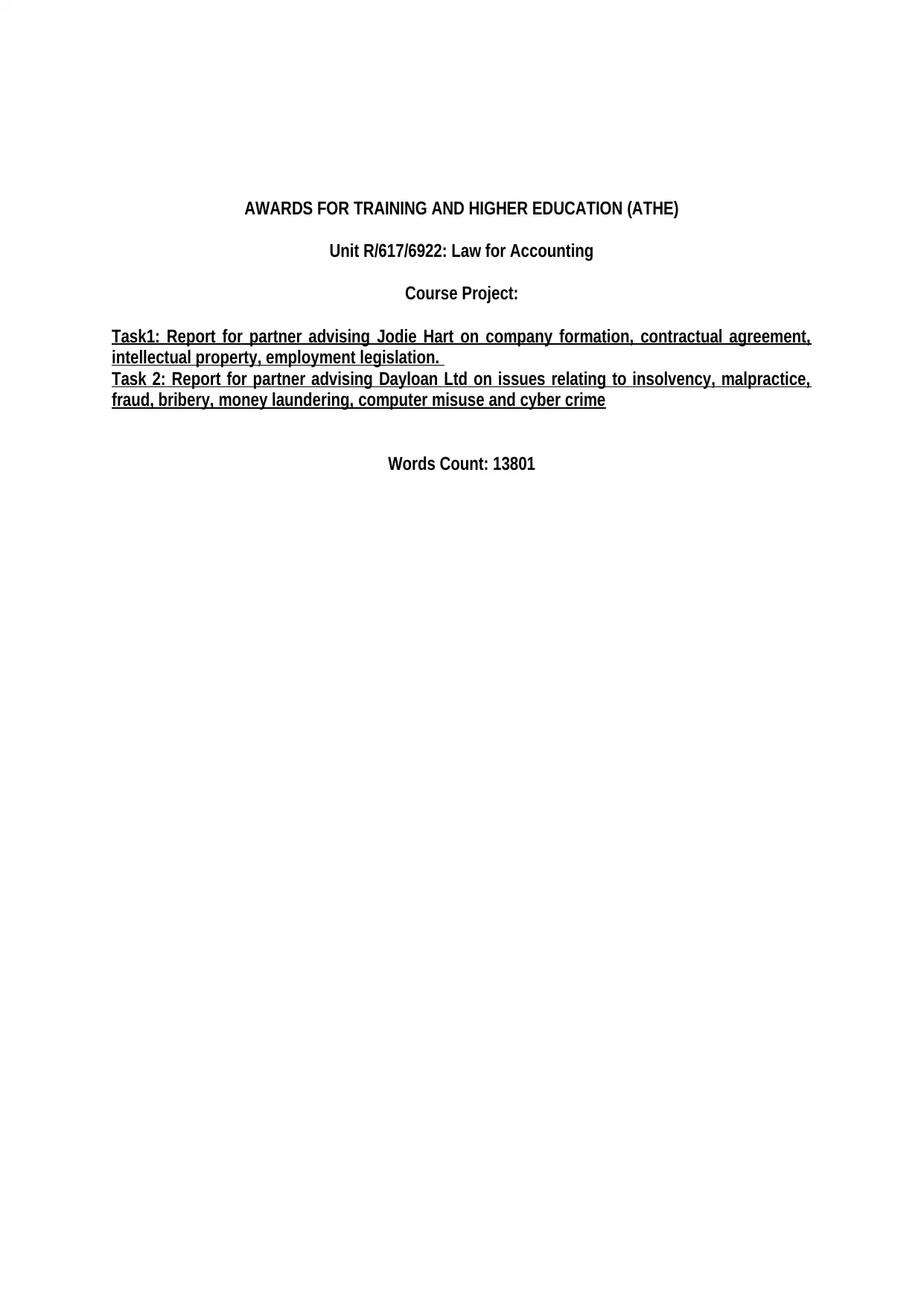
AWARDS FOR TRAINING AND HIGHER EDUCATION (ATHE)
Unit R/617/6922: Law for Accounting
Course Project:
Task1: Report for partner advising Jodie Hart on company formation, contractual agreement,
intellectual property, employment legislation.
Task 2: Report for partner advising Dayloan Ltd on issues relating to insolvency, malpractice,
fraud, bribery, money laundering, computer misuse and cyber crime
Words Count: 13801
Unit R/617/6922: Law for Accounting
Course Project:
Task1: Report for partner advising Jodie Hart on company formation, contractual agreement,
intellectual property, employment legislation.
Task 2: Report for partner advising Dayloan Ltd on issues relating to insolvency, malpractice,
fraud, bribery, money laundering, computer misuse and cyber crime
Words Count: 13801
Paraphrase This Document
Need a fresh take? Get an instant paraphrase of this document with our AI Paraphraser
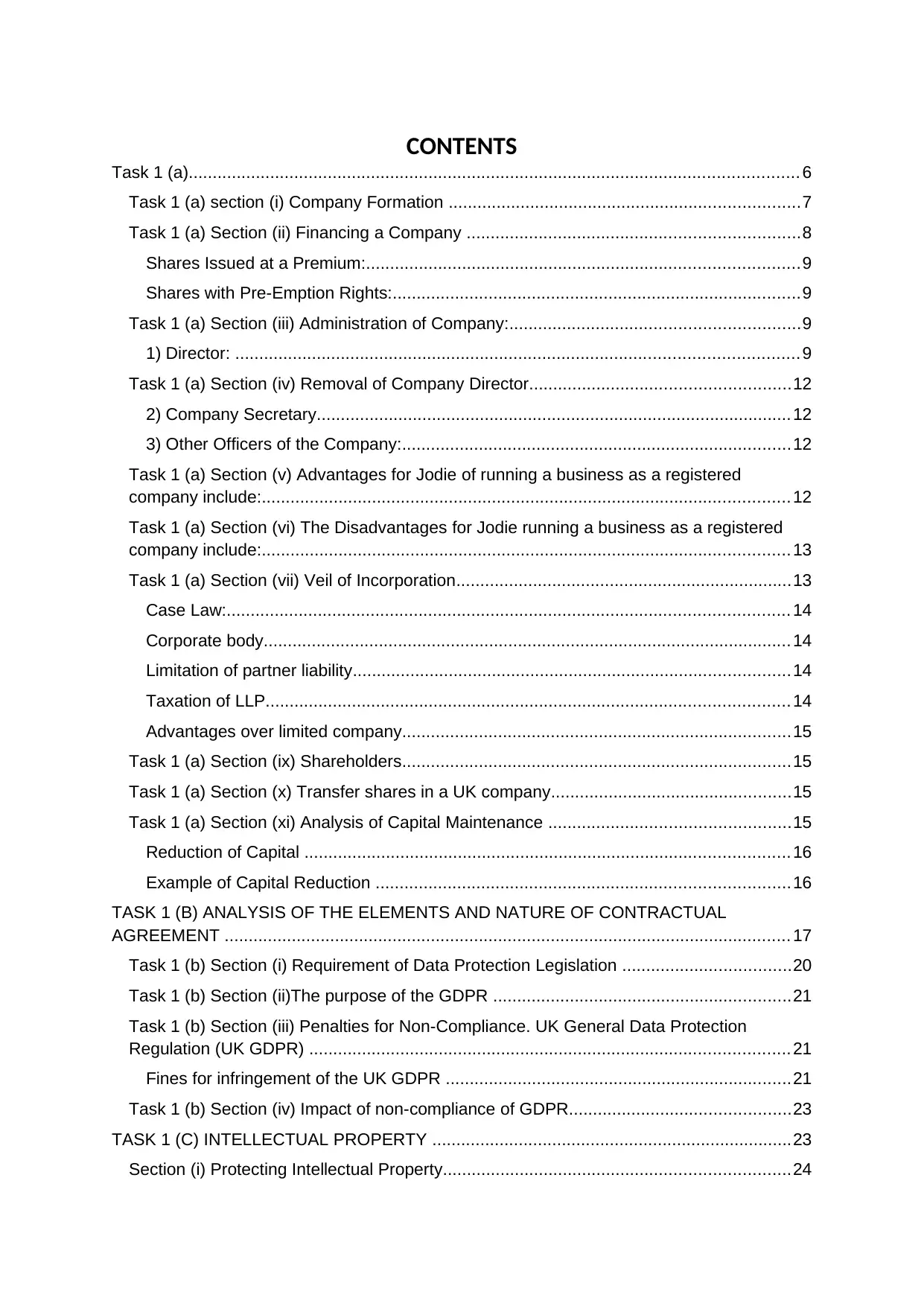
CONTENTS
Task 1 (a)............................................................................................................................... 6
Task 1 (a) section (i) Company Formation .........................................................................7
Task 1 (a) Section (ii) Financing a Company .....................................................................8
Shares Issued at a Premium:..........................................................................................9
Shares with Pre-Emption Rights:.....................................................................................9
Task 1 (a) Section (iii) Administration of Company:............................................................9
1) Director: ..................................................................................................................... 9
Task 1 (a) Section (iv) Removal of Company Director......................................................12
2) Company Secretary...................................................................................................12
3) Other Officers of the Company:.................................................................................12
Task 1 (a) Section (v) Advantages for Jodie of running a business as a registered
company include:.............................................................................................................. 12
Task 1 (a) Section (vi) The Disadvantages for Jodie running a business as a registered
company include:.............................................................................................................. 13
Task 1 (a) Section (vii) Veil of Incorporation......................................................................13
Case Law:..................................................................................................................... 14
Corporate body.............................................................................................................. 14
Limitation of partner liability...........................................................................................14
Taxation of LLP............................................................................................................. 14
Advantages over limited company.................................................................................15
Task 1 (a) Section (ix) Shareholders.................................................................................15
Task 1 (a) Section (x) Transfer shares in a UK company..................................................15
Task 1 (a) Section (xi) Analysis of Capital Maintenance ..................................................15
Reduction of Capital .....................................................................................................16
Example of Capital Reduction ......................................................................................16
TASK 1 (B) ANALYSIS OF THE ELEMENTS AND NATURE OF CONTRACTUAL
AGREEMENT ...................................................................................................................... 17
Task 1 (b) Section (i) Requirement of Data Protection Legislation ...................................20
Task 1 (b) Section (ii)The purpose of the GDPR ..............................................................21
Task 1 (b) Section (iii) Penalties for Non-Compliance. UK General Data Protection
Regulation (UK GDPR) ....................................................................................................21
Fines for infringement of the UK GDPR ........................................................................21
Task 1 (b) Section (iv) Impact of non-compliance of GDPR..............................................23
TASK 1 (C) INTELLECTUAL PROPERTY ...........................................................................23
Section (i) Protecting Intellectual Property........................................................................24
Task 1 (a)............................................................................................................................... 6
Task 1 (a) section (i) Company Formation .........................................................................7
Task 1 (a) Section (ii) Financing a Company .....................................................................8
Shares Issued at a Premium:..........................................................................................9
Shares with Pre-Emption Rights:.....................................................................................9
Task 1 (a) Section (iii) Administration of Company:............................................................9
1) Director: ..................................................................................................................... 9
Task 1 (a) Section (iv) Removal of Company Director......................................................12
2) Company Secretary...................................................................................................12
3) Other Officers of the Company:.................................................................................12
Task 1 (a) Section (v) Advantages for Jodie of running a business as a registered
company include:.............................................................................................................. 12
Task 1 (a) Section (vi) The Disadvantages for Jodie running a business as a registered
company include:.............................................................................................................. 13
Task 1 (a) Section (vii) Veil of Incorporation......................................................................13
Case Law:..................................................................................................................... 14
Corporate body.............................................................................................................. 14
Limitation of partner liability...........................................................................................14
Taxation of LLP............................................................................................................. 14
Advantages over limited company.................................................................................15
Task 1 (a) Section (ix) Shareholders.................................................................................15
Task 1 (a) Section (x) Transfer shares in a UK company..................................................15
Task 1 (a) Section (xi) Analysis of Capital Maintenance ..................................................15
Reduction of Capital .....................................................................................................16
Example of Capital Reduction ......................................................................................16
TASK 1 (B) ANALYSIS OF THE ELEMENTS AND NATURE OF CONTRACTUAL
AGREEMENT ...................................................................................................................... 17
Task 1 (b) Section (i) Requirement of Data Protection Legislation ...................................20
Task 1 (b) Section (ii)The purpose of the GDPR ..............................................................21
Task 1 (b) Section (iii) Penalties for Non-Compliance. UK General Data Protection
Regulation (UK GDPR) ....................................................................................................21
Fines for infringement of the UK GDPR ........................................................................21
Task 1 (b) Section (iv) Impact of non-compliance of GDPR..............................................23
TASK 1 (C) INTELLECTUAL PROPERTY ...........................................................................23
Section (i) Protecting Intellectual Property........................................................................24
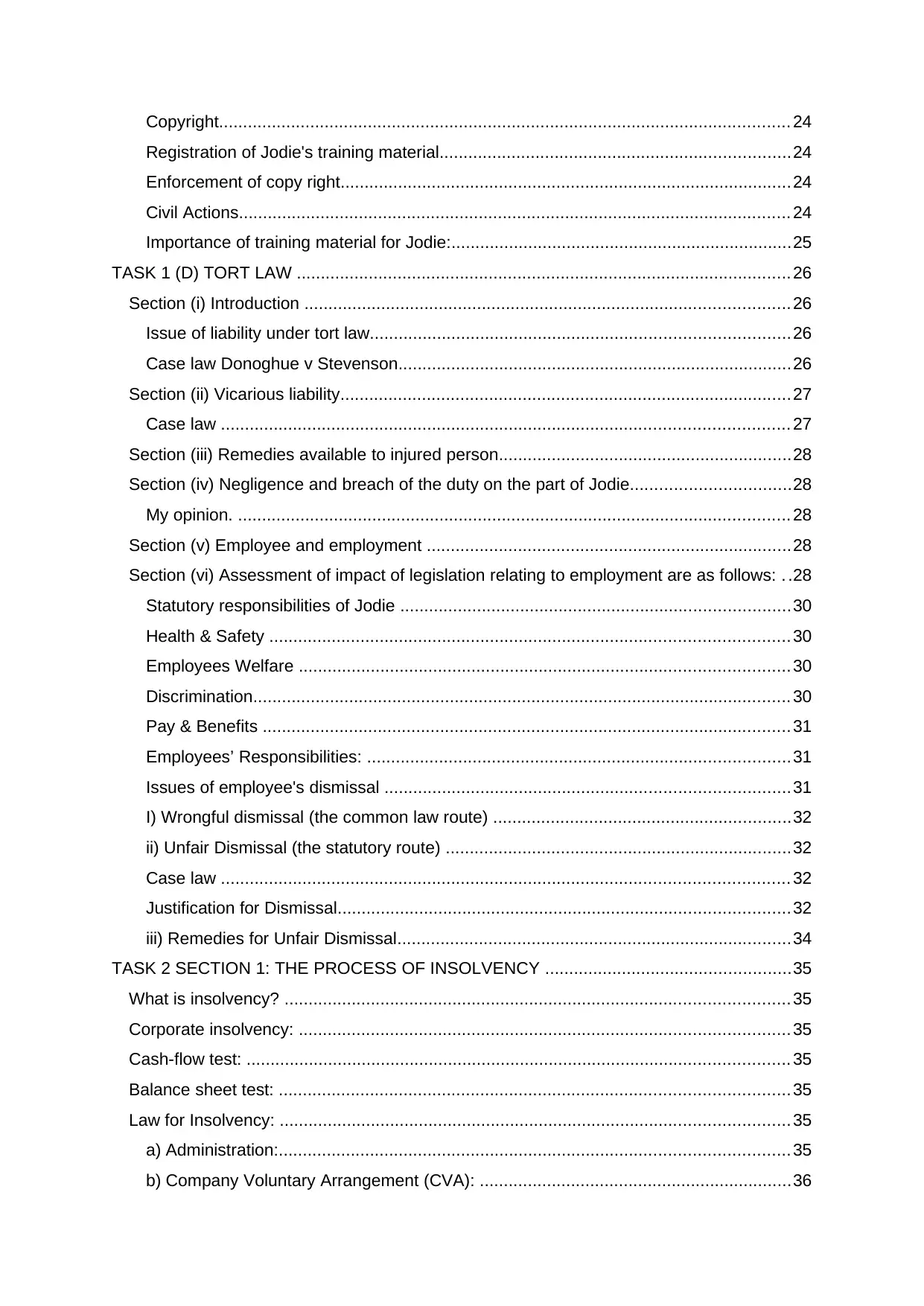
Copyright....................................................................................................................... 24
Registration of Jodie's training material.........................................................................24
Enforcement of copy right..............................................................................................24
Civil Actions................................................................................................................... 24
Importance of training material for Jodie:.......................................................................25
TASK 1 (D) TORT LAW .......................................................................................................26
Section (i) Introduction .....................................................................................................26
Issue of liability under tort law.......................................................................................26
Case law Donoghue v Stevenson..................................................................................26
Section (ii) Vicarious liability..............................................................................................27
Case law ...................................................................................................................... 27
Section (iii) Remedies available to injured person.............................................................28
Section (iv) Negligence and breach of the duty on the part of Jodie.................................28
My opinion. ................................................................................................................... 28
Section (v) Employee and employment ............................................................................28
Section (vi) Assessment of impact of legislation relating to employment are as follows: . .28
Statutory responsibilities of Jodie .................................................................................30
Health & Safety ............................................................................................................ 30
Employees Welfare ......................................................................................................30
Discrimination................................................................................................................ 30
Pay & Benefits .............................................................................................................. 31
Employees’ Responsibilities: ........................................................................................31
Issues of employee's dismissal ....................................................................................31
I) Wrongful dismissal (the common law route) ..............................................................32
ii) Unfair Dismissal (the statutory route) ........................................................................32
Case law ...................................................................................................................... 32
Justification for Dismissal..............................................................................................32
iii) Remedies for Unfair Dismissal..................................................................................34
TASK 2 SECTION 1: THE PROCESS OF INSOLVENCY ...................................................35
What is insolvency? .........................................................................................................35
Corporate insolvency: ......................................................................................................35
Cash-flow test: ................................................................................................................. 35
Balance sheet test: .......................................................................................................... 35
Law for Insolvency: ..........................................................................................................35
a) Administration:.......................................................................................................... 35
b) Company Voluntary Arrangement (CVA): .................................................................36
Registration of Jodie's training material.........................................................................24
Enforcement of copy right..............................................................................................24
Civil Actions................................................................................................................... 24
Importance of training material for Jodie:.......................................................................25
TASK 1 (D) TORT LAW .......................................................................................................26
Section (i) Introduction .....................................................................................................26
Issue of liability under tort law.......................................................................................26
Case law Donoghue v Stevenson..................................................................................26
Section (ii) Vicarious liability..............................................................................................27
Case law ...................................................................................................................... 27
Section (iii) Remedies available to injured person.............................................................28
Section (iv) Negligence and breach of the duty on the part of Jodie.................................28
My opinion. ................................................................................................................... 28
Section (v) Employee and employment ............................................................................28
Section (vi) Assessment of impact of legislation relating to employment are as follows: . .28
Statutory responsibilities of Jodie .................................................................................30
Health & Safety ............................................................................................................ 30
Employees Welfare ......................................................................................................30
Discrimination................................................................................................................ 30
Pay & Benefits .............................................................................................................. 31
Employees’ Responsibilities: ........................................................................................31
Issues of employee's dismissal ....................................................................................31
I) Wrongful dismissal (the common law route) ..............................................................32
ii) Unfair Dismissal (the statutory route) ........................................................................32
Case law ...................................................................................................................... 32
Justification for Dismissal..............................................................................................32
iii) Remedies for Unfair Dismissal..................................................................................34
TASK 2 SECTION 1: THE PROCESS OF INSOLVENCY ...................................................35
What is insolvency? .........................................................................................................35
Corporate insolvency: ......................................................................................................35
Cash-flow test: ................................................................................................................. 35
Balance sheet test: .......................................................................................................... 35
Law for Insolvency: ..........................................................................................................35
a) Administration:.......................................................................................................... 35
b) Company Voluntary Arrangement (CVA): .................................................................36
⊘ This is a preview!⊘
Do you want full access?
Subscribe today to unlock all pages.

Trusted by 1+ million students worldwide
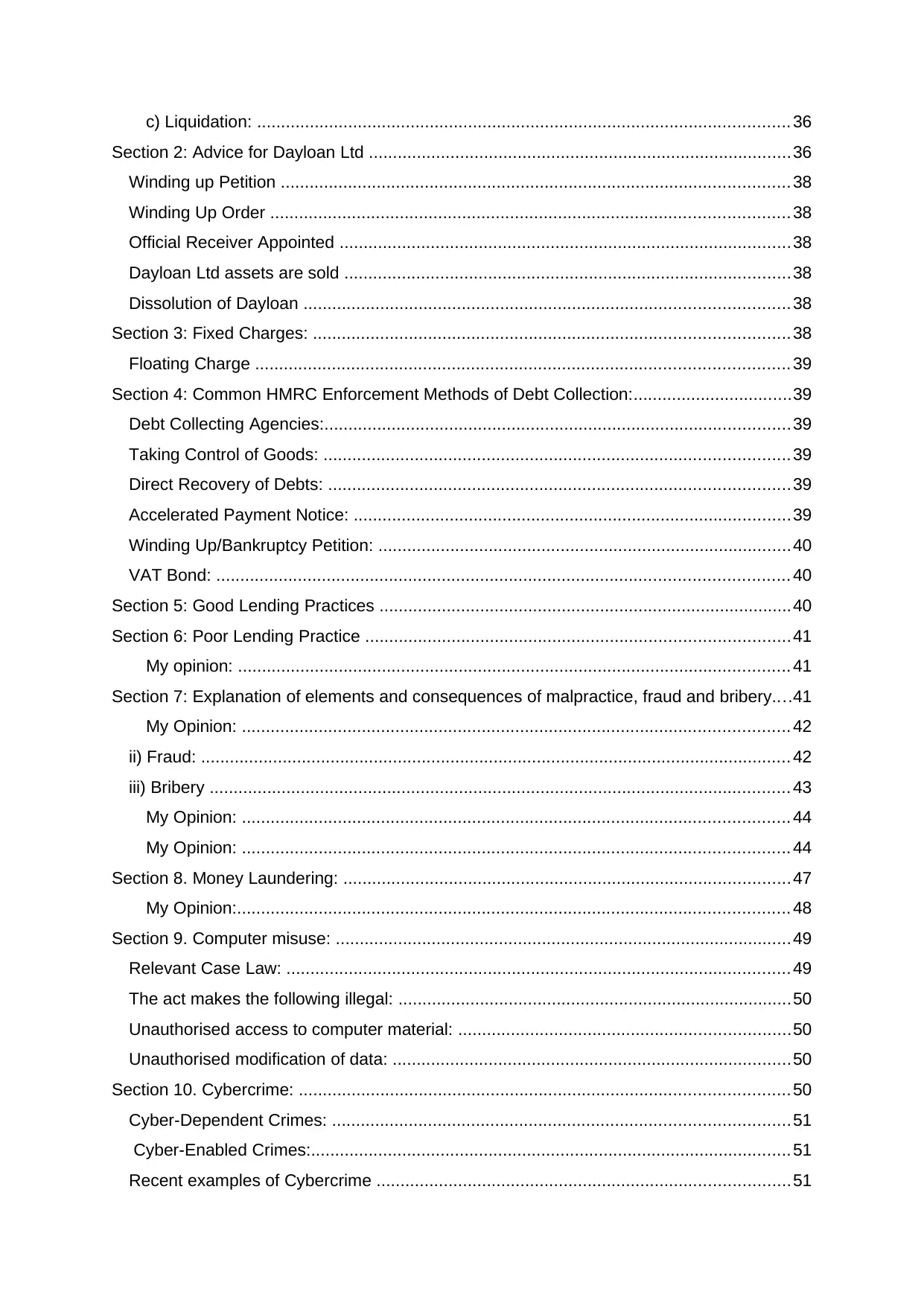
c) Liquidation: ............................................................................................................... 36
Section 2: Advice for Dayloan Ltd ........................................................................................36
Winding up Petition ..........................................................................................................38
Winding Up Order ............................................................................................................ 38
Official Receiver Appointed ..............................................................................................38
Dayloan Ltd assets are sold .............................................................................................38
Dissolution of Dayloan .....................................................................................................38
Section 3: Fixed Charges: ...................................................................................................38
Floating Charge ............................................................................................................... 39
Section 4: Common HMRC Enforcement Methods of Debt Collection:.................................39
Debt Collecting Agencies:.................................................................................................39
Taking Control of Goods: .................................................................................................39
Direct Recovery of Debts: ................................................................................................39
Accelerated Payment Notice: ...........................................................................................39
Winding Up/Bankruptcy Petition: ......................................................................................40
VAT Bond: ....................................................................................................................... 40
Section 5: Good Lending Practices ......................................................................................40
Section 6: Poor Lending Practice ........................................................................................41
My opinion: ................................................................................................................... 41
Section 7: Explanation of elements and consequences of malpractice, fraud and bribery....41
My Opinion: .................................................................................................................. 42
ii) Fraud: ........................................................................................................................... 42
iii) Bribery ......................................................................................................................... 43
My Opinion: .................................................................................................................. 44
My Opinion: .................................................................................................................. 44
Section 8. Money Laundering: .............................................................................................47
My Opinion:................................................................................................................... 48
Section 9. Computer misuse: ...............................................................................................49
Relevant Case Law: .........................................................................................................49
The act makes the following illegal: ..................................................................................50
Unauthorised access to computer material: .....................................................................50
Unauthorised modification of data: ...................................................................................50
Section 10. Cybercrime: ......................................................................................................50
Cyber-Dependent Crimes: ...............................................................................................51
Cyber-Enabled Crimes:....................................................................................................51
Recent examples of Cybercrime ......................................................................................51
Section 2: Advice for Dayloan Ltd ........................................................................................36
Winding up Petition ..........................................................................................................38
Winding Up Order ............................................................................................................ 38
Official Receiver Appointed ..............................................................................................38
Dayloan Ltd assets are sold .............................................................................................38
Dissolution of Dayloan .....................................................................................................38
Section 3: Fixed Charges: ...................................................................................................38
Floating Charge ............................................................................................................... 39
Section 4: Common HMRC Enforcement Methods of Debt Collection:.................................39
Debt Collecting Agencies:.................................................................................................39
Taking Control of Goods: .................................................................................................39
Direct Recovery of Debts: ................................................................................................39
Accelerated Payment Notice: ...........................................................................................39
Winding Up/Bankruptcy Petition: ......................................................................................40
VAT Bond: ....................................................................................................................... 40
Section 5: Good Lending Practices ......................................................................................40
Section 6: Poor Lending Practice ........................................................................................41
My opinion: ................................................................................................................... 41
Section 7: Explanation of elements and consequences of malpractice, fraud and bribery....41
My Opinion: .................................................................................................................. 42
ii) Fraud: ........................................................................................................................... 42
iii) Bribery ......................................................................................................................... 43
My Opinion: .................................................................................................................. 44
My Opinion: .................................................................................................................. 44
Section 8. Money Laundering: .............................................................................................47
My Opinion:................................................................................................................... 48
Section 9. Computer misuse: ...............................................................................................49
Relevant Case Law: .........................................................................................................49
The act makes the following illegal: ..................................................................................50
Unauthorised access to computer material: .....................................................................50
Unauthorised modification of data: ...................................................................................50
Section 10. Cybercrime: ......................................................................................................50
Cyber-Dependent Crimes: ...............................................................................................51
Cyber-Enabled Crimes:....................................................................................................51
Recent examples of Cybercrime ......................................................................................51
Paraphrase This Document
Need a fresh take? Get an instant paraphrase of this document with our AI Paraphraser
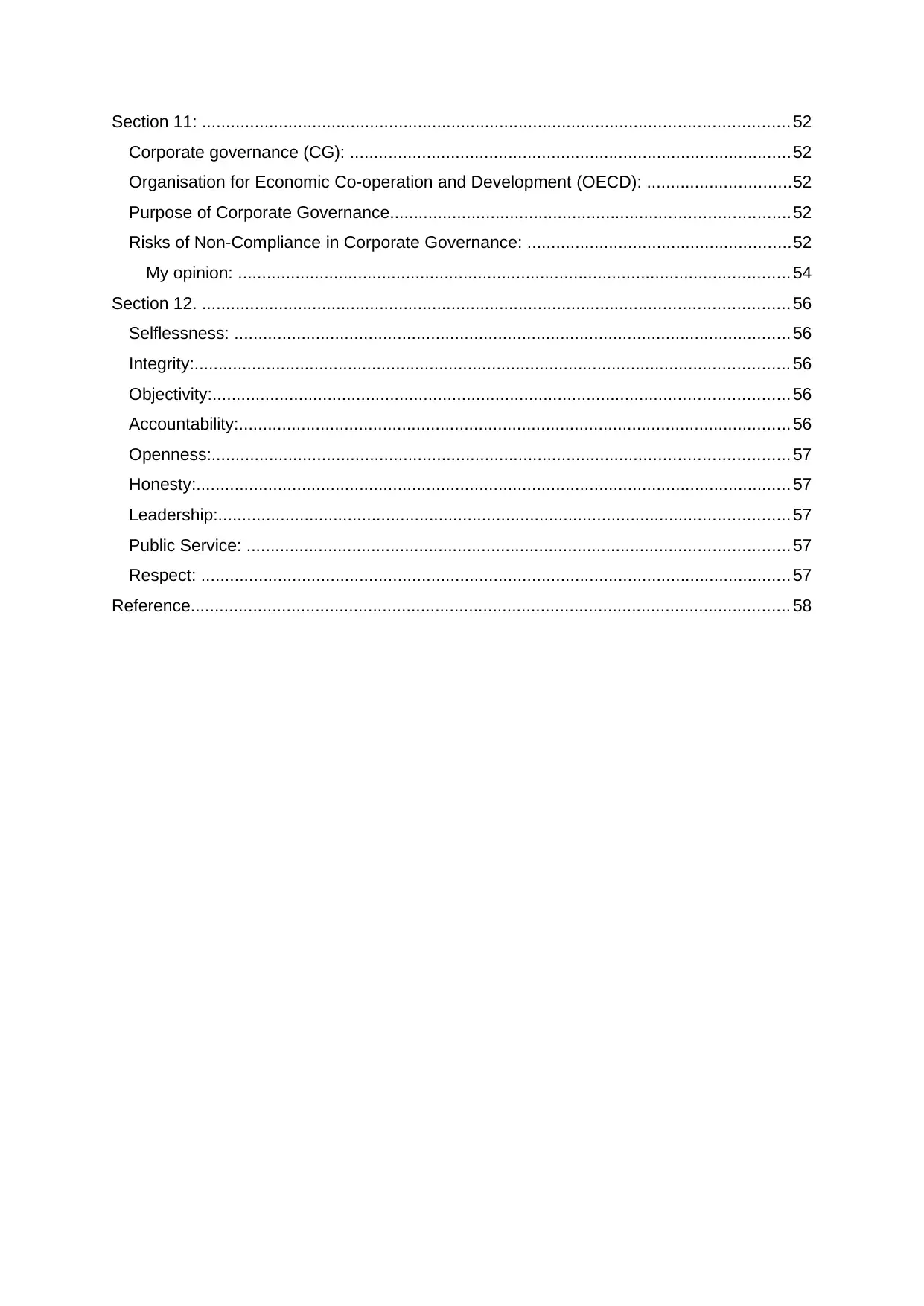
Section 11: .......................................................................................................................... 52
Corporate governance (CG): ............................................................................................52
Organisation for Economic Co-operation and Development (OECD): ..............................52
Purpose of Corporate Governance...................................................................................52
Risks of Non-Compliance in Corporate Governance: .......................................................52
My opinion: ................................................................................................................... 54
Section 12. .......................................................................................................................... 56
Selflessness: .................................................................................................................... 56
Integrity:............................................................................................................................ 56
Objectivity:........................................................................................................................ 56
Accountability:................................................................................................................... 56
Openness:........................................................................................................................ 57
Honesty:............................................................................................................................ 57
Leadership:....................................................................................................................... 57
Public Service: ................................................................................................................. 57
Respect: ........................................................................................................................... 57
Reference............................................................................................................................. 58
Corporate governance (CG): ............................................................................................52
Organisation for Economic Co-operation and Development (OECD): ..............................52
Purpose of Corporate Governance...................................................................................52
Risks of Non-Compliance in Corporate Governance: .......................................................52
My opinion: ................................................................................................................... 54
Section 12. .......................................................................................................................... 56
Selflessness: .................................................................................................................... 56
Integrity:............................................................................................................................ 56
Objectivity:........................................................................................................................ 56
Accountability:................................................................................................................... 56
Openness:........................................................................................................................ 57
Honesty:............................................................................................................................ 57
Leadership:....................................................................................................................... 57
Public Service: ................................................................................................................. 57
Respect: ........................................................................................................................... 57
Reference............................................................................................................................. 58
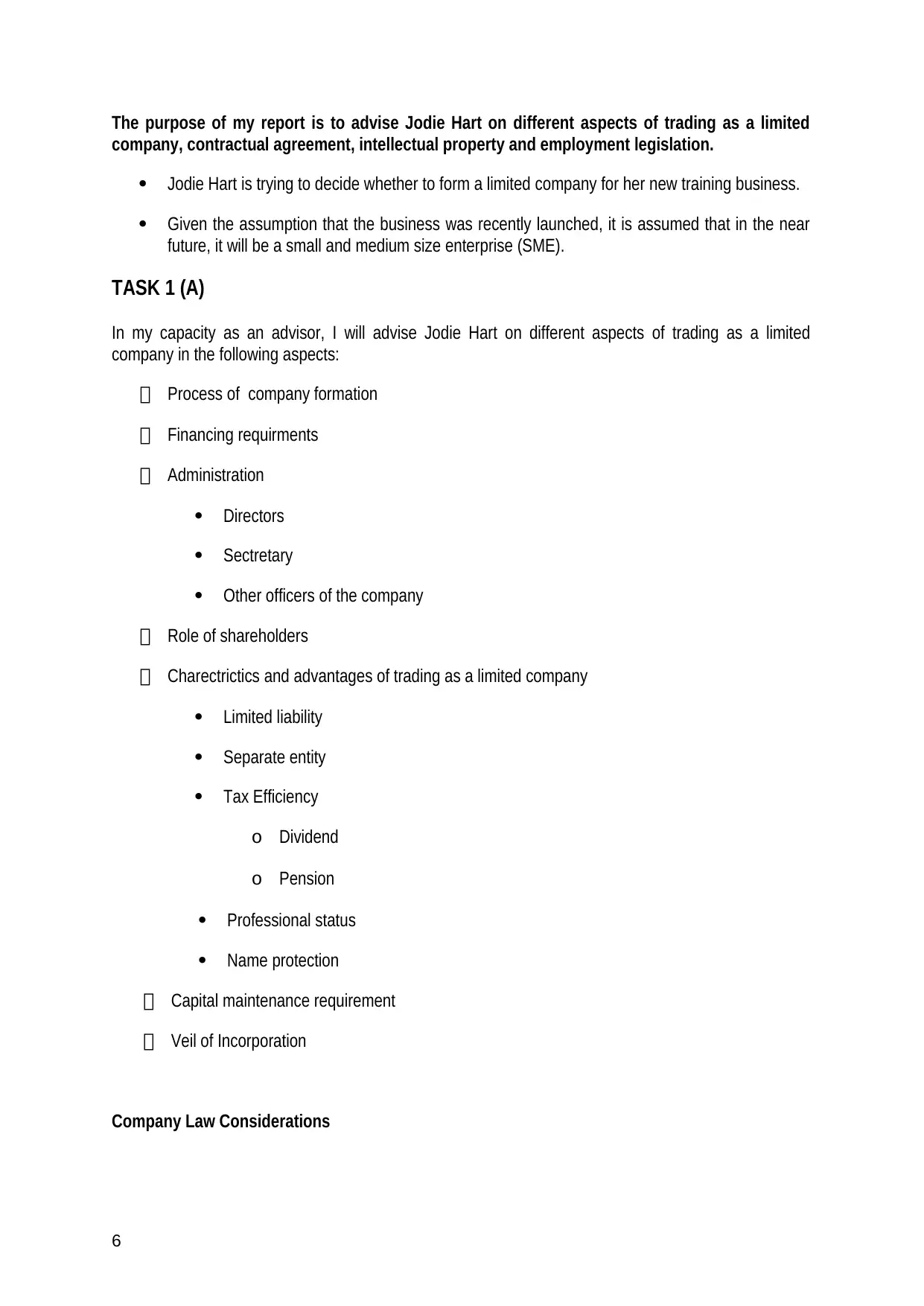
The purpose of my report is to advise Jodie Hart on different aspects of trading as a limited
company, contractual agreement, intellectual property and employment legislation.
Jodie Hart is trying to decide whether to form a limited company for her new training business.
Given the assumption that the business was recently launched, it is assumed that in the near
future, it will be a small and medium size enterprise (SME).
TASK 1 (A)
In my capacity as an advisor, I will advise Jodie Hart on different aspects of trading as a limited
company in the following aspects:
Process of company formation
Financing requirments
Administration
Directors
Sectretary
Other officers of the company
Role of shareholders
Charectrictics and advantages of trading as a limited company
Limited liability
Separate entity
Tax Efficiency
o Dividend
o Pension
Professional status
Name protection
Capital maintenance requirement
Veil of Incorporation
Company Law Considerations
6
company, contractual agreement, intellectual property and employment legislation.
Jodie Hart is trying to decide whether to form a limited company for her new training business.
Given the assumption that the business was recently launched, it is assumed that in the near
future, it will be a small and medium size enterprise (SME).
TASK 1 (A)
In my capacity as an advisor, I will advise Jodie Hart on different aspects of trading as a limited
company in the following aspects:
Process of company formation
Financing requirments
Administration
Directors
Sectretary
Other officers of the company
Role of shareholders
Charectrictics and advantages of trading as a limited company
Limited liability
Separate entity
Tax Efficiency
o Dividend
o Pension
Professional status
Name protection
Capital maintenance requirement
Veil of Incorporation
Company Law Considerations
6
⊘ This is a preview!⊘
Do you want full access?
Subscribe today to unlock all pages.

Trusted by 1+ million students worldwide
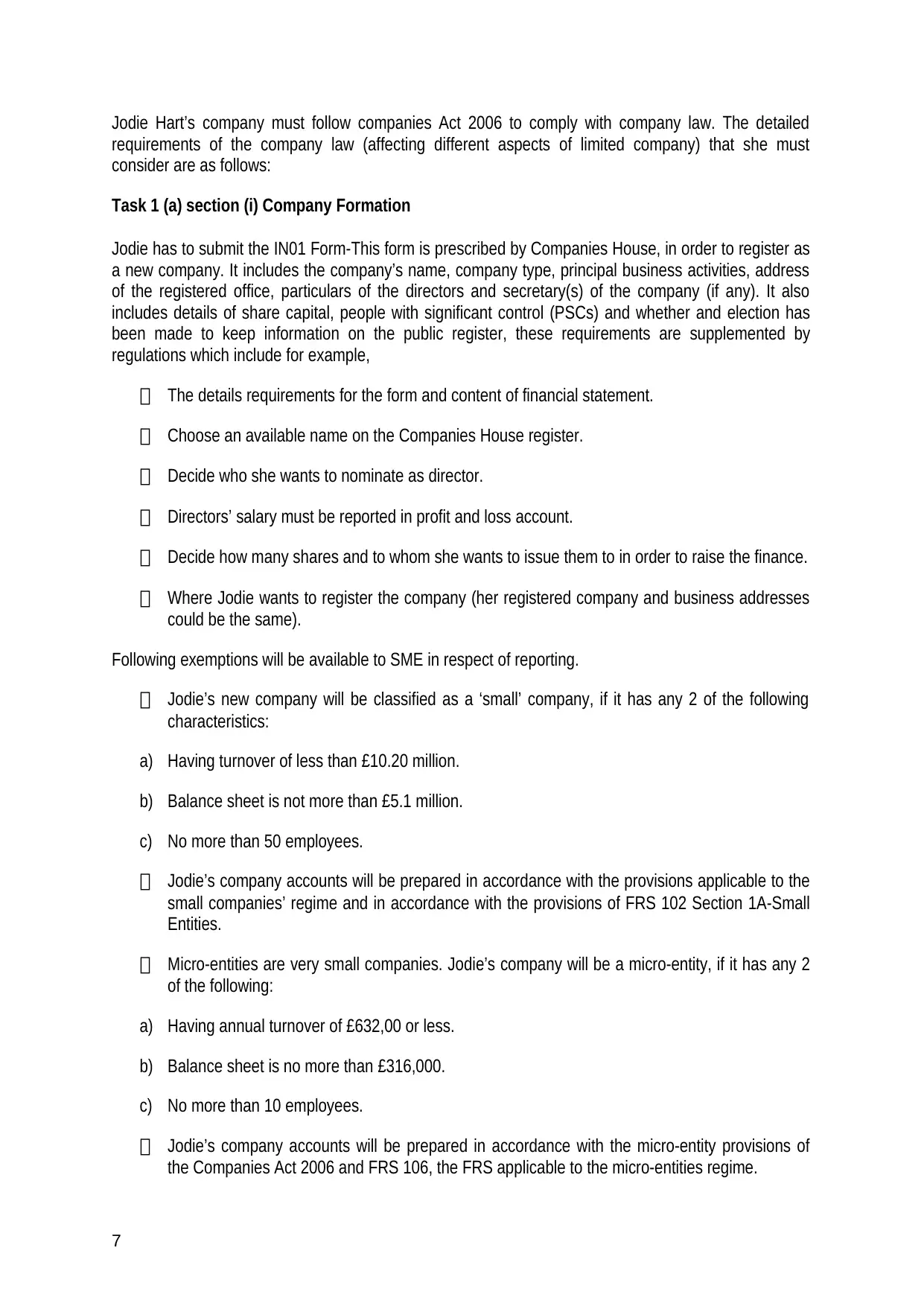
Jodie Hart’s company must follow companies Act 2006 to comply with company law. The detailed
requirements of the company law (affecting different aspects of limited company) that she must
consider are as follows:
Task 1 (a) section (i) Company Formation
Jodie has to submit the IN01 Form-This form is prescribed by Companies House, in order to register as
a new company. It includes the company’s name, company type, principal business activities, address
of the registered office, particulars of the directors and secretary(s) of the company (if any). It also
includes details of share capital, people with significant control (PSCs) and whether and election has
been made to keep information on the public register, these requirements are supplemented by
regulations which include for example,
The details requirements for the form and content of financial statement.
Choose an available name on the Companies House register.
Decide who she wants to nominate as director.
Directors’ salary must be reported in profit and loss account.
Decide how many shares and to whom she wants to issue them to in order to raise the finance.
Where Jodie wants to register the company (her registered company and business addresses
could be the same).
Following exemptions will be available to SME in respect of reporting.
Jodie’s new company will be classified as a ‘small’ company, if it has any 2 of the following
characteristics:
a) Having turnover of less than £10.20 million.
b) Balance sheet is not more than £5.1 million.
c) No more than 50 employees.
Jodie’s company accounts will be prepared in accordance with the provisions applicable to the
small companies’ regime and in accordance with the provisions of FRS 102 Section 1A-Small
Entities.
Micro-entities are very small companies. Jodie’s company will be a micro-entity, if it has any 2
of the following:
a) Having annual turnover of £632,00 or less.
b) Balance sheet is no more than £316,000.
c) No more than 10 employees.
Jodie’s company accounts will be prepared in accordance with the micro-entity provisions of
the Companies Act 2006 and FRS 106, the FRS applicable to the micro-entities regime.
7
requirements of the company law (affecting different aspects of limited company) that she must
consider are as follows:
Task 1 (a) section (i) Company Formation
Jodie has to submit the IN01 Form-This form is prescribed by Companies House, in order to register as
a new company. It includes the company’s name, company type, principal business activities, address
of the registered office, particulars of the directors and secretary(s) of the company (if any). It also
includes details of share capital, people with significant control (PSCs) and whether and election has
been made to keep information on the public register, these requirements are supplemented by
regulations which include for example,
The details requirements for the form and content of financial statement.
Choose an available name on the Companies House register.
Decide who she wants to nominate as director.
Directors’ salary must be reported in profit and loss account.
Decide how many shares and to whom she wants to issue them to in order to raise the finance.
Where Jodie wants to register the company (her registered company and business addresses
could be the same).
Following exemptions will be available to SME in respect of reporting.
Jodie’s new company will be classified as a ‘small’ company, if it has any 2 of the following
characteristics:
a) Having turnover of less than £10.20 million.
b) Balance sheet is not more than £5.1 million.
c) No more than 50 employees.
Jodie’s company accounts will be prepared in accordance with the provisions applicable to the
small companies’ regime and in accordance with the provisions of FRS 102 Section 1A-Small
Entities.
Micro-entities are very small companies. Jodie’s company will be a micro-entity, if it has any 2
of the following:
a) Having annual turnover of £632,00 or less.
b) Balance sheet is no more than £316,000.
c) No more than 10 employees.
Jodie’s company accounts will be prepared in accordance with the micro-entity provisions of
the Companies Act 2006 and FRS 106, the FRS applicable to the micro-entities regime.
7
Paraphrase This Document
Need a fresh take? Get an instant paraphrase of this document with our AI Paraphraser
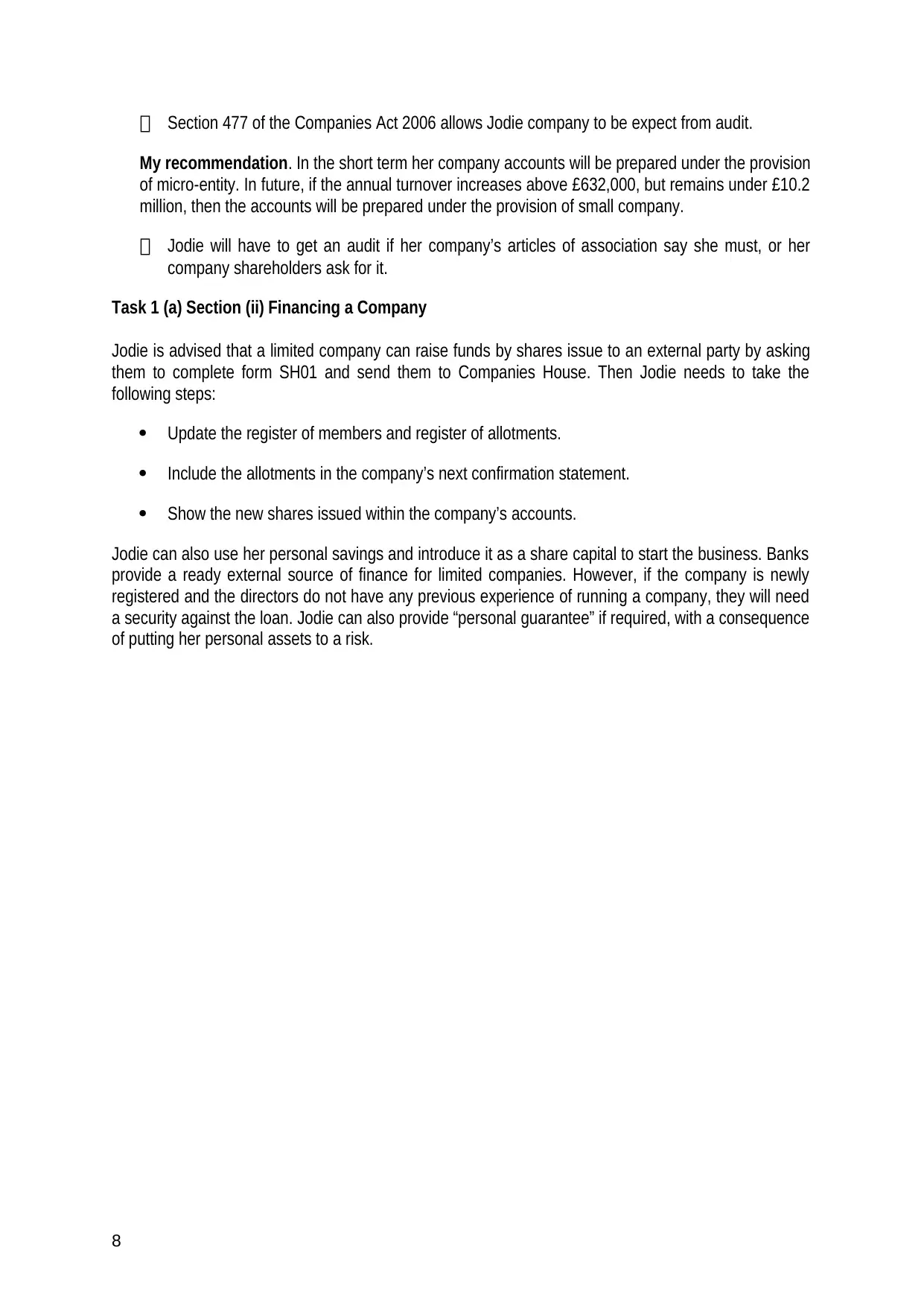
Section 477 of the Companies Act 2006 allows Jodie company to be expect from audit.
My recommendation. In the short term her company accounts will be prepared under the provision
of micro-entity. In future, if the annual turnover increases above £632,000, but remains under £10.2
million, then the accounts will be prepared under the provision of small company.
Jodie will have to get an audit if her company’s articles of association say she must, or her
company shareholders ask for it.
Task 1 (a) Section (ii) Financing a Company
Jodie is advised that a limited company can raise funds by shares issue to an external party by asking
them to complete form SH01 and send them to Companies House. Then Jodie needs to take the
following steps:
Update the register of members and register of allotments.
Include the allotments in the company’s next confirmation statement.
Show the new shares issued within the company’s accounts.
Jodie can also use her personal savings and introduce it as a share capital to start the business. Banks
provide a ready external source of finance for limited companies. However, if the company is newly
registered and the directors do not have any previous experience of running a company, they will need
a security against the loan. Jodie can also provide “personal guarantee” if required, with a consequence
of putting her personal assets to a risk.
8
My recommendation. In the short term her company accounts will be prepared under the provision
of micro-entity. In future, if the annual turnover increases above £632,000, but remains under £10.2
million, then the accounts will be prepared under the provision of small company.
Jodie will have to get an audit if her company’s articles of association say she must, or her
company shareholders ask for it.
Task 1 (a) Section (ii) Financing a Company
Jodie is advised that a limited company can raise funds by shares issue to an external party by asking
them to complete form SH01 and send them to Companies House. Then Jodie needs to take the
following steps:
Update the register of members and register of allotments.
Include the allotments in the company’s next confirmation statement.
Show the new shares issued within the company’s accounts.
Jodie can also use her personal savings and introduce it as a share capital to start the business. Banks
provide a ready external source of finance for limited companies. However, if the company is newly
registered and the directors do not have any previous experience of running a company, they will need
a security against the loan. Jodie can also provide “personal guarantee” if required, with a consequence
of putting her personal assets to a risk.
8
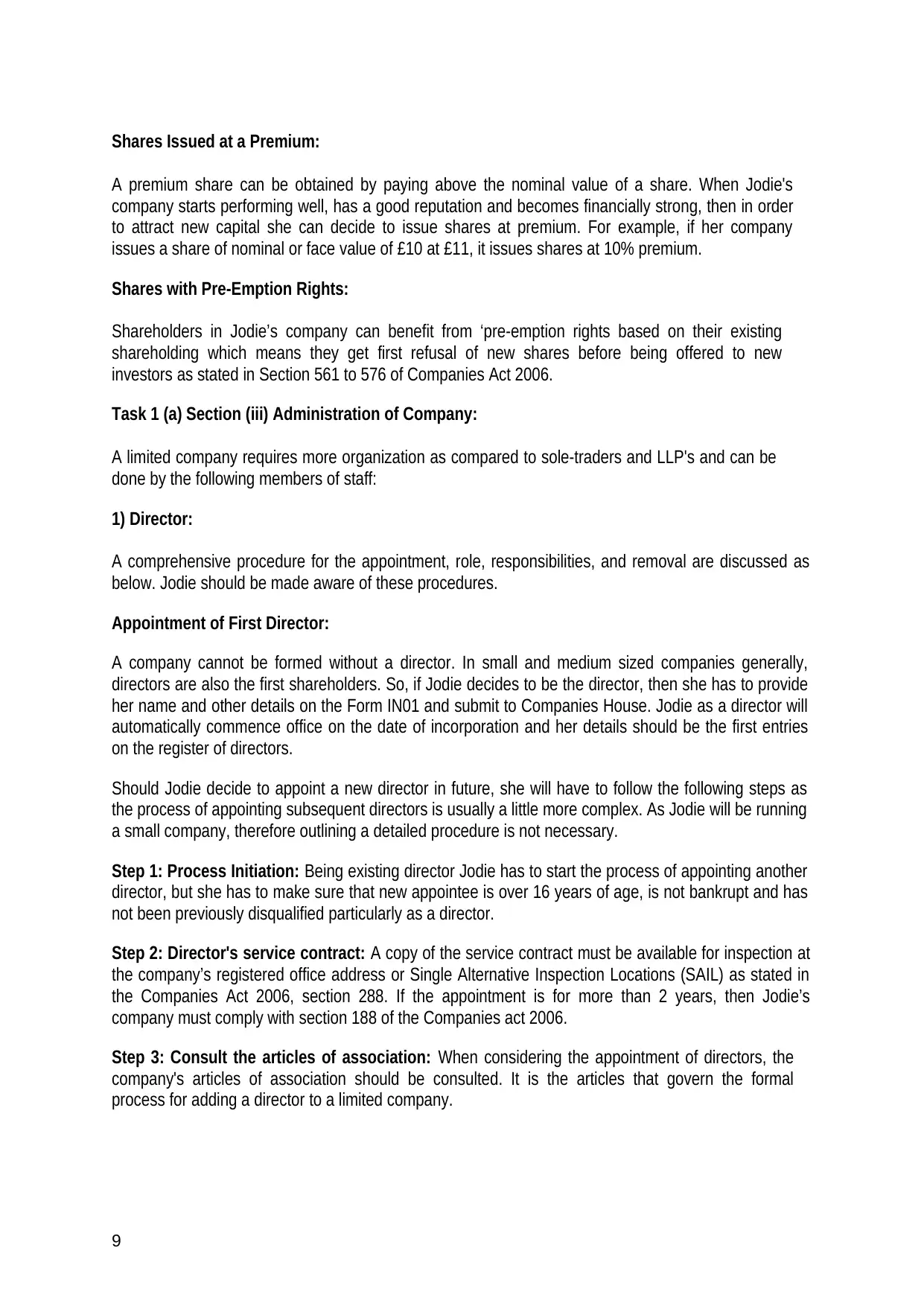
Shares Issued at a Premium:
A premium share can be obtained by paying above the nominal value of a share. When Jodie's
company starts performing well, has a good reputation and becomes financially strong, then in order
to attract new capital she can decide to issue shares at premium. For example, if her company
issues a share of nominal or face value of £10 at £11, it issues shares at 10% premium.
Shares with Pre-Emption Rights:
Shareholders in Jodie’s company can benefit from ‘pre-emption rights based on their existing
shareholding which means they get first refusal of new shares before being offered to new
investors as stated in Section 561 to 576 of Companies Act 2006.
Task 1 (a) Section (iii) Administration of Company:
A limited company requires more organization as compared to sole-traders and LLP's and can be
done by the following members of staff:
1) Director:
A comprehensive procedure for the appointment, role, responsibilities, and removal are discussed as
below. Jodie should be made aware of these procedures.
Appointment of First Director:
A company cannot be formed without a director. In small and medium sized companies generally,
directors are also the first shareholders. So, if Jodie decides to be the director, then she has to provide
her name and other details on the Form IN01 and submit to Companies House. Jodie as a director will
automatically commence office on the date of incorporation and her details should be the first entries
on the register of directors.
Should Jodie decide to appoint a new director in future, she will have to follow the following steps as
the process of appointing subsequent directors is usually a little more complex. As Jodie will be running
a small company, therefore outlining a detailed procedure is not necessary.
Step 1: Process Initiation: Being existing director Jodie has to start the process of appointing another
director, but she has to make sure that new appointee is over 16 years of age, is not bankrupt and has
not been previously disqualified particularly as a director.
Step 2: Director's service contract: A copy of the service contract must be available for inspection at
the company’s registered office address or Single Alternative Inspection Locations (SAIL) as stated in
the Companies Act 2006, section 288. If the appointment is for more than 2 years, then Jodie’s
company must comply with section 188 of the Companies act 2006.
Step 3: Consult the articles of association: When considering the appointment of directors, the
company's articles of association should be consulted. It is the articles that govern the formal
process for adding a director to a limited company.
9
A premium share can be obtained by paying above the nominal value of a share. When Jodie's
company starts performing well, has a good reputation and becomes financially strong, then in order
to attract new capital she can decide to issue shares at premium. For example, if her company
issues a share of nominal or face value of £10 at £11, it issues shares at 10% premium.
Shares with Pre-Emption Rights:
Shareholders in Jodie’s company can benefit from ‘pre-emption rights based on their existing
shareholding which means they get first refusal of new shares before being offered to new
investors as stated in Section 561 to 576 of Companies Act 2006.
Task 1 (a) Section (iii) Administration of Company:
A limited company requires more organization as compared to sole-traders and LLP's and can be
done by the following members of staff:
1) Director:
A comprehensive procedure for the appointment, role, responsibilities, and removal are discussed as
below. Jodie should be made aware of these procedures.
Appointment of First Director:
A company cannot be formed without a director. In small and medium sized companies generally,
directors are also the first shareholders. So, if Jodie decides to be the director, then she has to provide
her name and other details on the Form IN01 and submit to Companies House. Jodie as a director will
automatically commence office on the date of incorporation and her details should be the first entries
on the register of directors.
Should Jodie decide to appoint a new director in future, she will have to follow the following steps as
the process of appointing subsequent directors is usually a little more complex. As Jodie will be running
a small company, therefore outlining a detailed procedure is not necessary.
Step 1: Process Initiation: Being existing director Jodie has to start the process of appointing another
director, but she has to make sure that new appointee is over 16 years of age, is not bankrupt and has
not been previously disqualified particularly as a director.
Step 2: Director's service contract: A copy of the service contract must be available for inspection at
the company’s registered office address or Single Alternative Inspection Locations (SAIL) as stated in
the Companies Act 2006, section 288. If the appointment is for more than 2 years, then Jodie’s
company must comply with section 188 of the Companies act 2006.
Step 3: Consult the articles of association: When considering the appointment of directors, the
company's articles of association should be consulted. It is the articles that govern the formal
process for adding a director to a limited company.
9
⊘ This is a preview!⊘
Do you want full access?
Subscribe today to unlock all pages.

Trusted by 1+ million students worldwide
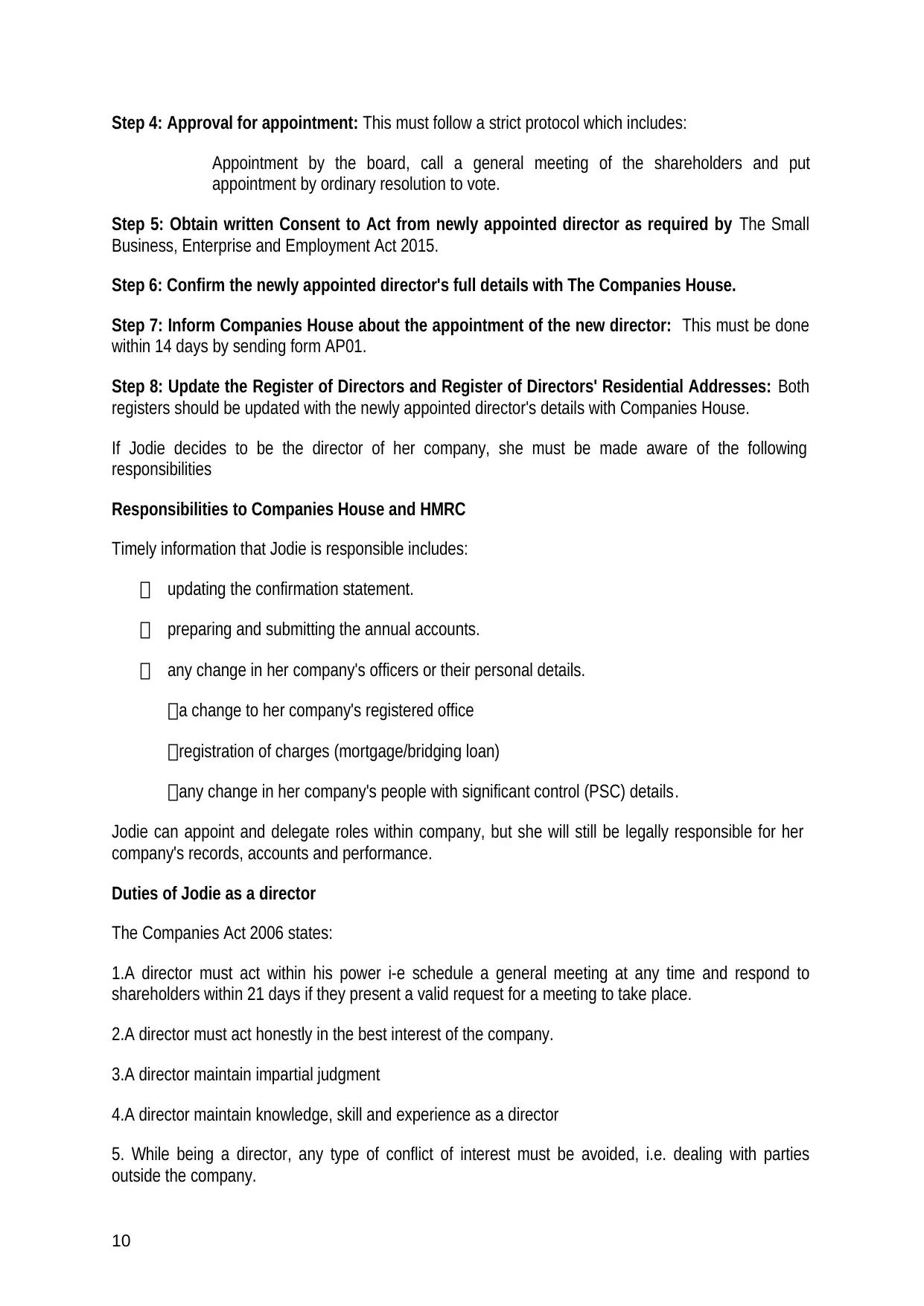
Step 4: Approval for appointment: This must follow a strict protocol which includes:
Appointment by the board, call a general meeting of the shareholders and put
appointment by ordinary resolution to vote.
Step 5: Obtain written Consent to Act from newly appointed director as required by The Small
Business, Enterprise and Employment Act 2015.
Step 6: Confirm the newly appointed director's full details with The Companies House.
Step 7: Inform Companies House about the appointment of the new director: This must be done
within 14 days by sending form AP01.
Step 8: Update the Register of Directors and Register of Directors' Residential Addresses: Both
registers should be updated with the newly appointed director's details with Companies House.
If Jodie decides to be the director of her company, she must be made aware of the following
responsibilities
Responsibilities to Companies House and HMRC
Timely information that Jodie is responsible includes:
updating the confirmation statement.
preparing and submitting the annual accounts.
any change in her company's officers or their personal details.
a change to her company's registered office
registration of charges (mortgage/bridging loan)
any change in her company's people with significant control (PSC) details.
Jodie can appoint and delegate roles within company, but she will still be legally responsible for her
company's records, accounts and performance.
Duties of Jodie as a director
The Companies Act 2006 states:
1.A director must act within his power i-e schedule a general meeting at any time and respond to
shareholders within 21 days if they present a valid request for a meeting to take place.
2.A director must act honestly in the best interest of the company.
3.A director maintain impartial judgment
4.A director maintain knowledge, skill and experience as a director
5. While being a director, any type of conflict of interest must be avoided, i.e. dealing with parties
outside the company.
10
Appointment by the board, call a general meeting of the shareholders and put
appointment by ordinary resolution to vote.
Step 5: Obtain written Consent to Act from newly appointed director as required by The Small
Business, Enterprise and Employment Act 2015.
Step 6: Confirm the newly appointed director's full details with The Companies House.
Step 7: Inform Companies House about the appointment of the new director: This must be done
within 14 days by sending form AP01.
Step 8: Update the Register of Directors and Register of Directors' Residential Addresses: Both
registers should be updated with the newly appointed director's details with Companies House.
If Jodie decides to be the director of her company, she must be made aware of the following
responsibilities
Responsibilities to Companies House and HMRC
Timely information that Jodie is responsible includes:
updating the confirmation statement.
preparing and submitting the annual accounts.
any change in her company's officers or their personal details.
a change to her company's registered office
registration of charges (mortgage/bridging loan)
any change in her company's people with significant control (PSC) details.
Jodie can appoint and delegate roles within company, but she will still be legally responsible for her
company's records, accounts and performance.
Duties of Jodie as a director
The Companies Act 2006 states:
1.A director must act within his power i-e schedule a general meeting at any time and respond to
shareholders within 21 days if they present a valid request for a meeting to take place.
2.A director must act honestly in the best interest of the company.
3.A director maintain impartial judgment
4.A director maintain knowledge, skill and experience as a director
5. While being a director, any type of conflict of interest must be avoided, i.e. dealing with parties
outside the company.
10
Paraphrase This Document
Need a fresh take? Get an instant paraphrase of this document with our AI Paraphraser
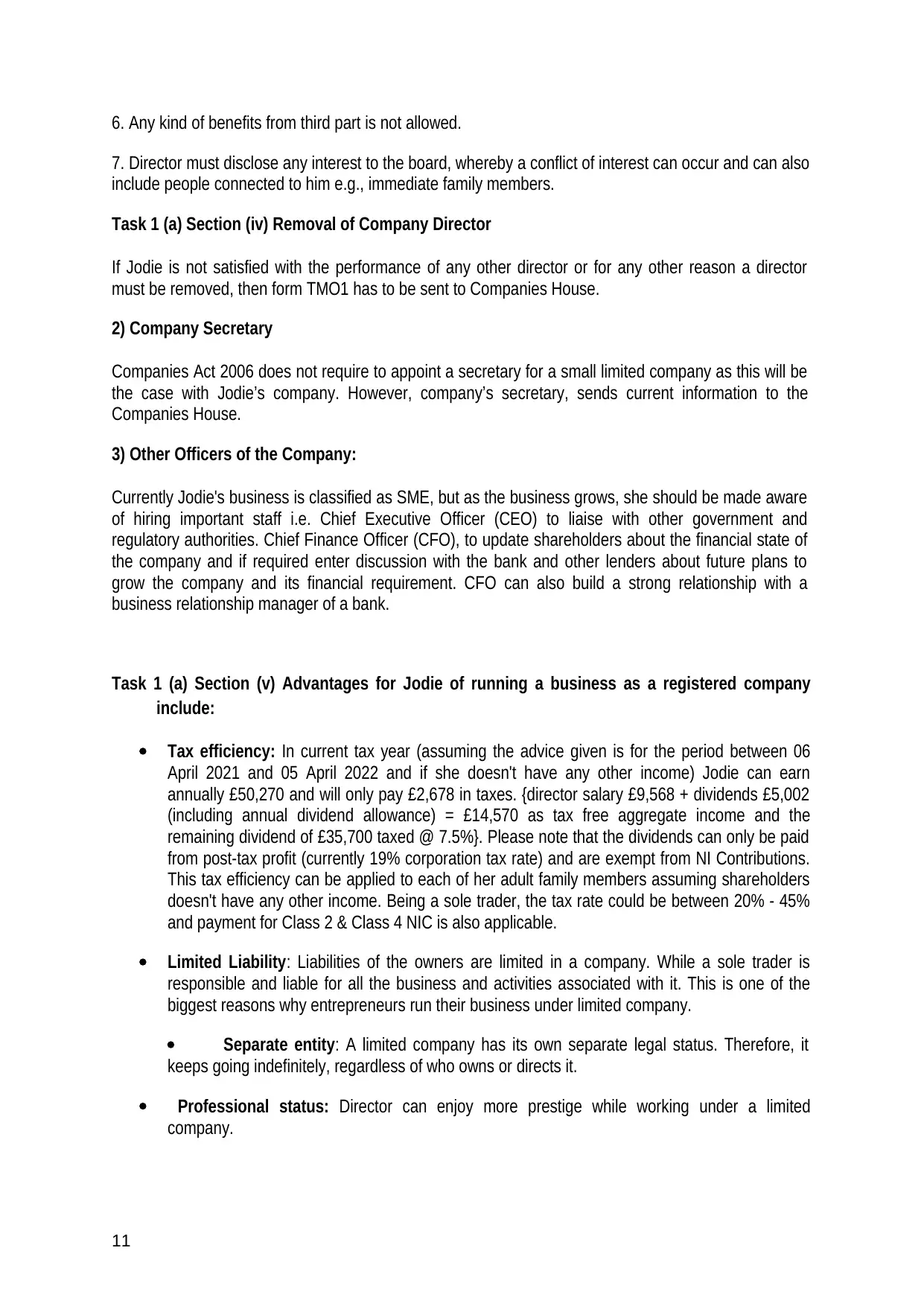
6. Any kind of benefits from third part is not allowed.
7. Director must disclose any interest to the board, whereby a conflict of interest can occur and can also
include people connected to him e.g., immediate family members.
Task 1 (a) Section (iv) Removal of Company Director
If Jodie is not satisfied with the performance of any other director or for any other reason a director
must be removed, then form TMO1 has to be sent to Companies House.
2) Company Secretary
Companies Act 2006 does not require to appoint a secretary for a small limited company as this will be
the case with Jodie’s company. However, company’s secretary, sends current information to the
Companies House.
3) Other Officers of the Company:
Currently Jodie's business is classified as SME, but as the business grows, she should be made aware
of hiring important staff i.e. Chief Executive Officer (CEO) to liaise with other government and
regulatory authorities. Chief Finance Officer (CFO), to update shareholders about the financial state of
the company and if required enter discussion with the bank and other lenders about future plans to
grow the company and its financial requirement. CFO can also build a strong relationship with a
business relationship manager of a bank.
Task 1 (a) Section (v) Advantages for Jodie of running a business as a registered company
include:
Tax efficiency: In current tax year (assuming the advice given is for the period between 06
April 2021 and 05 April 2022 and if she doesn't have any other income) Jodie can earn
annually £50,270 and will only pay £2,678 in taxes. {director salary £9,568 + dividends £5,002
(including annual dividend allowance) = £14,570 as tax free aggregate income and the
remaining dividend of £35,700 taxed @ 7.5%}. Please note that the dividends can only be paid
from post-tax profit (currently 19% corporation tax rate) and are exempt from NI Contributions.
This tax efficiency can be applied to each of her adult family members assuming shareholders
doesn't have any other income. Being a sole trader, the tax rate could be between 20% - 45%
and payment for Class 2 & Class 4 NIC is also applicable.
Limited Liability: Liabilities of the owners are limited in a company. While a sole trader is
responsible and liable for all the business and activities associated with it. This is one of the
biggest reasons why entrepreneurs run their business under limited company.
Separate entity: A limited company has its own separate legal status. Therefore, it
keeps going indefinitely, regardless of who owns or directs it.
Professional status: Director can enjoy more prestige while working under a limited
company.
11
7. Director must disclose any interest to the board, whereby a conflict of interest can occur and can also
include people connected to him e.g., immediate family members.
Task 1 (a) Section (iv) Removal of Company Director
If Jodie is not satisfied with the performance of any other director or for any other reason a director
must be removed, then form TMO1 has to be sent to Companies House.
2) Company Secretary
Companies Act 2006 does not require to appoint a secretary for a small limited company as this will be
the case with Jodie’s company. However, company’s secretary, sends current information to the
Companies House.
3) Other Officers of the Company:
Currently Jodie's business is classified as SME, but as the business grows, she should be made aware
of hiring important staff i.e. Chief Executive Officer (CEO) to liaise with other government and
regulatory authorities. Chief Finance Officer (CFO), to update shareholders about the financial state of
the company and if required enter discussion with the bank and other lenders about future plans to
grow the company and its financial requirement. CFO can also build a strong relationship with a
business relationship manager of a bank.
Task 1 (a) Section (v) Advantages for Jodie of running a business as a registered company
include:
Tax efficiency: In current tax year (assuming the advice given is for the period between 06
April 2021 and 05 April 2022 and if she doesn't have any other income) Jodie can earn
annually £50,270 and will only pay £2,678 in taxes. {director salary £9,568 + dividends £5,002
(including annual dividend allowance) = £14,570 as tax free aggregate income and the
remaining dividend of £35,700 taxed @ 7.5%}. Please note that the dividends can only be paid
from post-tax profit (currently 19% corporation tax rate) and are exempt from NI Contributions.
This tax efficiency can be applied to each of her adult family members assuming shareholders
doesn't have any other income. Being a sole trader, the tax rate could be between 20% - 45%
and payment for Class 2 & Class 4 NIC is also applicable.
Limited Liability: Liabilities of the owners are limited in a company. While a sole trader is
responsible and liable for all the business and activities associated with it. This is one of the
biggest reasons why entrepreneurs run their business under limited company.
Separate entity: A limited company has its own separate legal status. Therefore, it
keeps going indefinitely, regardless of who owns or directs it.
Professional status: Director can enjoy more prestige while working under a limited
company.
11
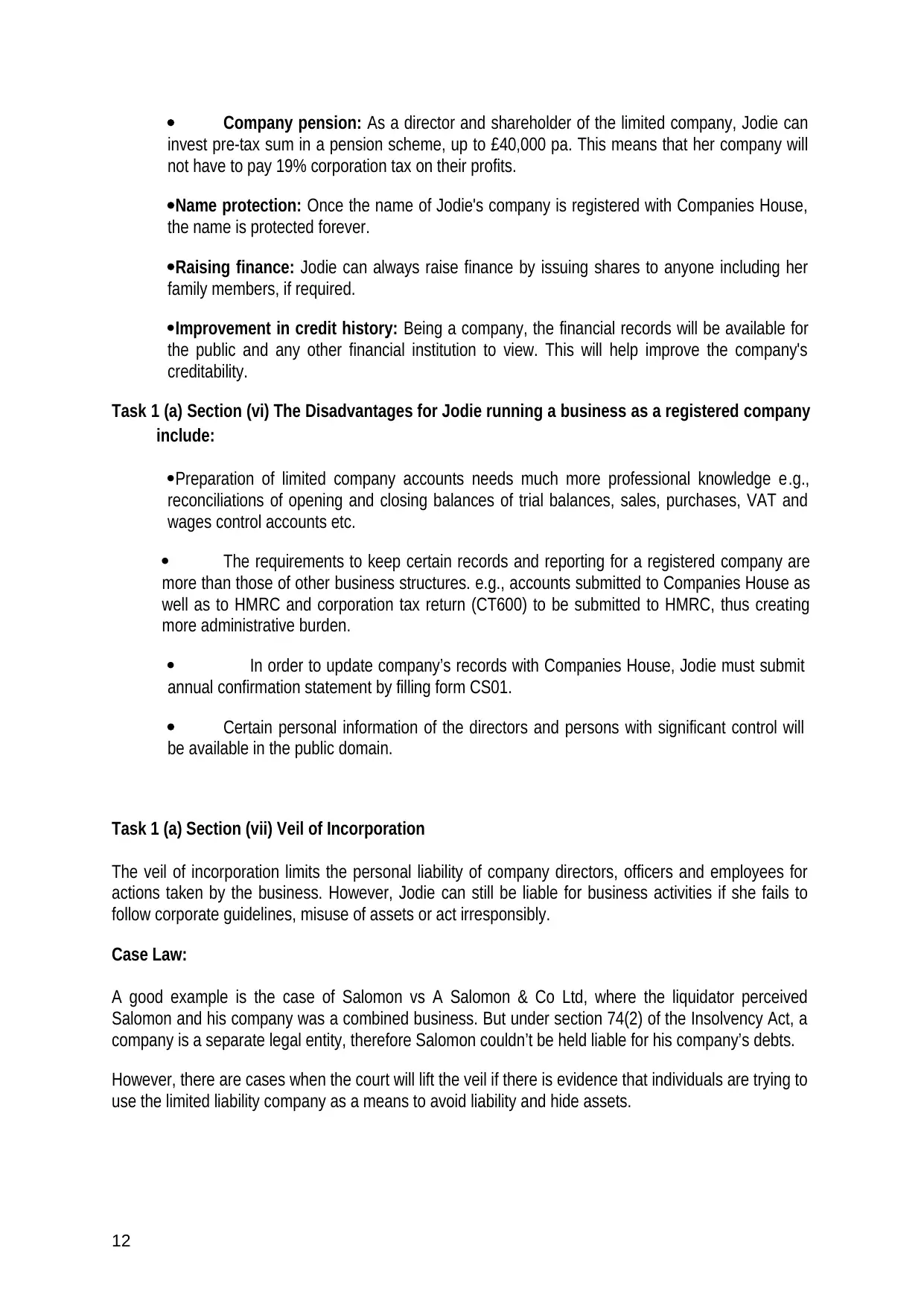
Company pension: As a director and shareholder of the limited company, Jodie can
invest pre-tax sum in a pension scheme, up to £40,000 pa. This means that her company will
not have to pay 19% corporation tax on their profits.
Name protection: Once the name of Jodie's company is registered with Companies House,
the name is protected forever.
Raising finance: Jodie can always raise finance by issuing shares to anyone including her
family members, if required.
Improvement in credit history: Being a company, the financial records will be available for
the public and any other financial institution to view. This will help improve the company's
creditability.
Task 1 (a) Section (vi) The Disadvantages for Jodie running a business as a registered company
include:
Preparation of limited company accounts needs much more professional knowledge e.g.,
reconciliations of opening and closing balances of trial balances, sales, purchases, VAT and
wages control accounts etc.
The requirements to keep certain records and reporting for a registered company are
more than those of other business structures. e.g., accounts submitted to Companies House as
well as to HMRC and corporation tax return (CT600) to be submitted to HMRC, thus creating
more administrative burden.
In order to update company’s records with Companies House, Jodie must submit
annual confirmation statement by filling form CS01.
Certain personal information of the directors and persons with significant control will
be available in the public domain.
Task 1 (a) Section (vii) Veil of Incorporation
The veil of incorporation limits the personal liability of company directors, officers and employees for
actions taken by the business. However, Jodie can still be liable for business activities if she fails to
follow corporate guidelines, misuse of assets or act irresponsibly.
Case Law:
A good example is the case of Salomon vs A Salomon & Co Ltd, where the liquidator perceived
Salomon and his company was a combined business. But under section 74(2) of the Insolvency Act, a
company is a separate legal entity, therefore Salomon couldn’t be held liable for his company’s debts.
However, there are cases when the court will lift the veil if there is evidence that individuals are trying to
use the limited liability company as a means to avoid liability and hide assets.
12
invest pre-tax sum in a pension scheme, up to £40,000 pa. This means that her company will
not have to pay 19% corporation tax on their profits.
Name protection: Once the name of Jodie's company is registered with Companies House,
the name is protected forever.
Raising finance: Jodie can always raise finance by issuing shares to anyone including her
family members, if required.
Improvement in credit history: Being a company, the financial records will be available for
the public and any other financial institution to view. This will help improve the company's
creditability.
Task 1 (a) Section (vi) The Disadvantages for Jodie running a business as a registered company
include:
Preparation of limited company accounts needs much more professional knowledge e.g.,
reconciliations of opening and closing balances of trial balances, sales, purchases, VAT and
wages control accounts etc.
The requirements to keep certain records and reporting for a registered company are
more than those of other business structures. e.g., accounts submitted to Companies House as
well as to HMRC and corporation tax return (CT600) to be submitted to HMRC, thus creating
more administrative burden.
In order to update company’s records with Companies House, Jodie must submit
annual confirmation statement by filling form CS01.
Certain personal information of the directors and persons with significant control will
be available in the public domain.
Task 1 (a) Section (vii) Veil of Incorporation
The veil of incorporation limits the personal liability of company directors, officers and employees for
actions taken by the business. However, Jodie can still be liable for business activities if she fails to
follow corporate guidelines, misuse of assets or act irresponsibly.
Case Law:
A good example is the case of Salomon vs A Salomon & Co Ltd, where the liquidator perceived
Salomon and his company was a combined business. But under section 74(2) of the Insolvency Act, a
company is a separate legal entity, therefore Salomon couldn’t be held liable for his company’s debts.
However, there are cases when the court will lift the veil if there is evidence that individuals are trying to
use the limited liability company as a means to avoid liability and hide assets.
12
⊘ This is a preview!⊘
Do you want full access?
Subscribe today to unlock all pages.

Trusted by 1+ million students worldwide
1 out of 57
Related Documents
Your All-in-One AI-Powered Toolkit for Academic Success.
+13062052269
info@desklib.com
Available 24*7 on WhatsApp / Email
![[object Object]](/_next/static/media/star-bottom.7253800d.svg)
Unlock your academic potential
Copyright © 2020–2025 A2Z Services. All Rights Reserved. Developed and managed by ZUCOL.





